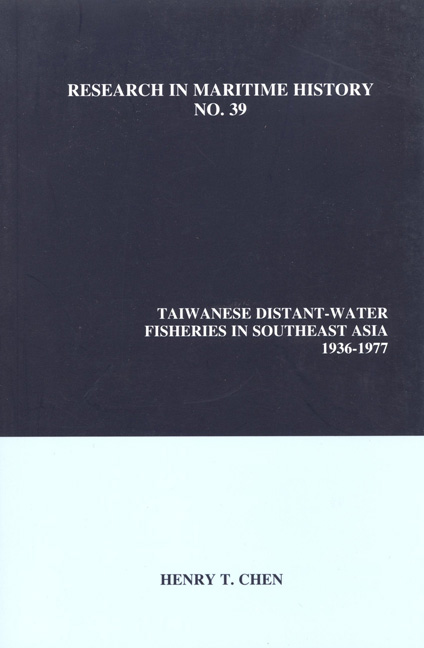Book contents
- Frontmatter
- Contents
- List of Tables
- List of Illustrations
- Notes on the Sources
- About the Author
- Acknowledgements
- Introduction
- Chapter 1 Japan and the Development of Taiwan's Fishing Industry
- Chapter 2 The Revival of the Fishing Industry in Postwar Taiwan
- Chapter 3 Kaohsiung Fishing Port and Its Fishing Ancillary Industries
- Chapter 4 The Taiwanese Fishing Industry and the Military-Political Complex
- Chapter 5 The Kaohsiung Fishing Industry and Its Ancillary Industries
- Chapter 6 The Development of Kaohsiung's Fishing Companies
- Chapter 7 Daily Lives at Sea, Fishing Zones and Politics
- Chapter 8 The Culture and Daily Life of the Kaohsiung Fishing Communities
- Chapter 9 The 1970s Crisis in the Taiwanese Fishing Industry
- Conclusion
- Appendix 1 List of Informants
- Select Bibliography
Chapter 2 - The Revival of the Fishing Industry in Postwar Taiwan
- Frontmatter
- Contents
- List of Tables
- List of Illustrations
- Notes on the Sources
- About the Author
- Acknowledgements
- Introduction
- Chapter 1 Japan and the Development of Taiwan's Fishing Industry
- Chapter 2 The Revival of the Fishing Industry in Postwar Taiwan
- Chapter 3 Kaohsiung Fishing Port and Its Fishing Ancillary Industries
- Chapter 4 The Taiwanese Fishing Industry and the Military-Political Complex
- Chapter 5 The Kaohsiung Fishing Industry and Its Ancillary Industries
- Chapter 6 The Development of Kaohsiung's Fishing Companies
- Chapter 7 Daily Lives at Sea, Fishing Zones and Politics
- Chapter 8 The Culture and Daily Life of the Kaohsiung Fishing Communities
- Chapter 9 The 1970s Crisis in the Taiwanese Fishing Industry
- Conclusion
- Appendix 1 List of Informants
- Select Bibliography
Summary
Although Taiwan's fishing industry suffered severe damage during World War II, it recovered quickly and achieved outstanding results. The purpose of this chapter is to describe and analyze this revival. Initially, I will provide a concise description of the damage caused by the war to Taiwan's fishing industry and the emergency measures undertaken by the postwar government to aid its recovery. I then examine the key role of the fisheries authorities in postwar Taiwan, describe their functions and show how they worked with one another. After addressing these questions, I explain both the endogenous and exogenous factors that contributed to the remarkable postwar growth. In particular, I draw attention to the fisheries policies and their influence on the development of modern technologies. Besides such internal factors, the revival of the Taiwanese industry benefited immensely from the assistance of the international community.
Emergency Measures for the Recovery of the Taiwanese Fishing Industry
World War II brought severe hardship to Taiwan's fishing industry. Numerous vessels were confiscated for military purposes and were subsequently lost in battle. Much of the rest of the fleet was sunk by American bombers. In short, the fishing industry experienced an unprecedented catastrophe. In 1940 the output from the distant-water fisheries sector was 57,122,328 kilograms. But this dwindled to a mere 68,307 kgs in 1945. The offshore sector contracted from 28,223,394 to 2,599,654 kgs (see tables 2.1 and 2.2).1 As a result, when the new postwar government took over in 1945, the fishing industry was in a sorry state and was still suffering severely from the devastation of the war years. Emergency measures for the reconstruction of the fishing industry became an immediate priority for the new government.
Soon after the Japanese surrender in 1945, personnel were dispatched by the Chinese government to supervise the operation of Taiwan's fishing industry. Numerous fishing companies and related enterprises were taken over and reorganized in a comparatively short time. Fishing Kaisha of Taiwan [Taiwan Suisan Kabushiki Kaisha], one of the leading fishing companies in the colonial era, was a good case in point. Most of its vessels had either been sunk or heavily damaged during the hostilities, and many of its branches, ice-manufacturing factories and shipbuilding plants were reduced to ashes.
- Type
- Chapter
- Information
- Publisher: Liverpool University PressPrint publication year: 2009



